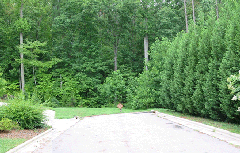Proposed new regulations would reform – or undermine, depending upon your point of view -- a keystone 2007 law designed to limit the negative impact of local land use decisions upon state roads.
By James A. Bacon
In 2007 members of the General Assembly were struck by a revelation: There were ways to address the problem of traffic congestion in Virginia that did not entail building expensive new roads and highways. Gridlock arises not only from a growing population and increasing traffic load but from poor planning and design. Accordingly, the legislature enacted a sweeping overhaul of state law regulating the interface of transportation and land use.
Provisions of the law required traffic impact analysis for new development, greater street connectivity between new subdivisions and tighter regulation of public access to state highways. The bipartisan action was widely regarded one of the signature achievements of the Kaine administration.
This year the General Assembly passed a law directing the Virginia Department of Transportation (VDOT) to review the legislation and enact new regulations as needed. A VDOT advisory committee has recommended several changes, which await approval either by the Virginia Highway Commissioner or the Commonwealth Transportation Board.
The revisions represent a victory for the real estate industry. Two measures – one that would reduce the size of rezoning projects required to conduct aTraffic Impact Analysis, and another that would modify regulations requiring new subdivisions to connect with one another – stand out as particularly important. The two provisions will relieve developers and home builders of significant regulatory costs while still preserving the intent of the original law, maintains Mike Toalson, executive vice president of the Home Builders Association of Virginia.
But smart growth activists say the proposed new regulations will dilute the effectiveness of what had been one of the most progressive efforts in the country to coordinate transportation and land use. Stewart Schwartz, executive director of the Coalition for Smarter Growth, described the 2007 law as an effort to stem the growing and unaffordable list of transportation projects requested by local government and passed up to the General Assembly.
“We will never have enough funds to build the quantity of infrastructure created by patterns of development that have been increasingly used since World War II,” Schwartz wrote to Virginia Highway Commissioner Gregory Whirley. “By preserving the throughput of our highway network through better access management, by measuring traffic impact and applying creative solutions to reduce demand, and by increasing local street connectivity to reduce demand and traffic on our overburdened arterial roadways, we can save the tax payers of Virginia huge sums of money that would otherwise be required for new highways, the widening of dozens of arterials, and the addition of dozens of new interchanges.”
The idea behind the regulations, says Trip Pollard, senior attorney with the Southern Environmental Law Center, is to look before you leap. “Yes, there is a cost, but it’s a very reasonable cost.” The proposed revisions “are not the end of the world,” he concedes, and Virginia still will be better off than five years ago. “But we’re losing a lot here. … If you don’t address transportation and land use, you’ll end up with sprawl and congestion.”
The revisions address three broad areas: traffic impact statements, secondary street acceptance requirements and access management regulations. (View VDOT's video presentation of the regulatory changes here.)
Under current law, developers are required to submit a Traffic Impact Analysis (TIA), which usually requires hiring a consultant, for rezoning requests that would result in 2,500 or more vehicle trips per day (or 400 per day on low-volume highways). The TIA must be submitted to VDOT for review. VDOT can recommend changes but counties are not bound to comply with them.
Home builders maintain that the requirement imposes an onerous cost on small builders, not to mention a significant demand on VDOT staff time. The cost to hire a consultant can range from $5,000 to $30,000 on smaller jobs up to hundreds of thousands of dollars on big projects, says Toalson with the Home Builders, and that doesn’t count the cost of delaying the project while the study is conducted. The proposed new regs would increase the threshold to projects generating 5,000 trips daily.
Pollard, the SELC attorney, says he can see the developers’ point of view and he was willing to compromise on the issue. He doesn’t have a problem with raising the threshold to 5,000 trips in areas with urban densities. But the number is too high for smaller communities and rural areas, where a 2,500-trip development could have a big impact.
Ted McCormack, who represents the Virginia Association of Counties, is pleased with the change. Under the revisions, he says, counties still would have the option of requiring developers of small projects to submit a TIA if county officials believe a study is warranted.
The other big sticking point involves a provision that governs how many road connections developers must create for their housing subdivisions. Currently, they must comply with a Connectivity Index, a mathematical formula that requires developers to create a certain number of connections between their subdivisions and neighboring roads depending upon how many miles of road are in the development. The idea is to provide drivers an alternative to using congested connector roads or arterials. If homeowners want to treat their neighborhood streets as private roads, they can – but VDOT has the right to refuse to accept the streets into the state-maintained system.
 No one argues with the principle, but the theory gets complicated when applied to real-world situations. For example, one subdivision may have a “stub out,” a road that dead ends at the edge of the subdivision (see photo at left) in order to create a connection when a neighboring subdivision is built. But when someone builds that neighboring subdivision and tries to connect with the stub out, residents of the first neighborhood complain about outside traffic disrupting their peaceful cul-de-sacs. When faced with irate homeowners, county supervisors often waive the connectivity requirement. If VDOT refuses to accept the streets from the second subdivision, it would be punishing the developer for a decision made by county boards at the behest of homeowners in the first subdivision, says Toalson.
No one argues with the principle, but the theory gets complicated when applied to real-world situations. For example, one subdivision may have a “stub out,” a road that dead ends at the edge of the subdivision (see photo at left) in order to create a connection when a neighboring subdivision is built. But when someone builds that neighboring subdivision and tries to connect with the stub out, residents of the first neighborhood complain about outside traffic disrupting their peaceful cul-de-sacs. When faced with irate homeowners, county supervisors often waive the connectivity requirement. If VDOT refuses to accept the streets from the second subdivision, it would be punishing the developer for a decision made by county boards at the behest of homeowners in the first subdivision, says Toalson.
Home builders also say the formula doesn’t take into account the fact that some subdivisions back up against railroad tracks, Interstate highways, rivers, ravines or other topographical feature that make it impractical to make extra connections.
The proposed new regs would replace the Connectivity Index with a requirement that a development would have to build an additional external connection for every 200 dwelling units, and it would allow the VDOT district administrator to waive requirements when barriers exist.
The Smart Growth lobbyists say it’s too early to change the Secondary Street Acceptance Requirements. Due to the housing bust, very few new subdivisions have been opened around the state. The acceptance requirements haven’t been given a chance to work, and the law is too important to water down.
“Interconnected local streets provide more options for people to move, to travel to the school or the store, without crowding the major through routes,” says Schwartz with the Coalition for Smarter Growth. “When developers are being allowed to build so many cul de sacs, VDOT has to respond by widening arterials and adding interchanges. …There would be a huge cost savings if a more interconnected network of streets were built.”
All things considered, says McCormack with the association of counties, the counties are satisfied with the changes. They’ll give counties more flexibility. “They’re more than a minor tweak, but they’re not gutting the [original] regulations.”
=============
This article was reported and written thanks to a sponsorship by the Piedmont Environmental Council.

